Zhenhua Xu
Train Once, Deploy Anywhere: Realize Data-Efficient Dynamic Object Manipulation
Aug 19, 2025Abstract:Realizing generalizable dynamic object manipulation is important for enhancing manufacturing efficiency, as it eliminates specialized engineering for various scenarios. To this end, imitation learning emerges as a promising paradigm, leveraging expert demonstrations to teach a policy manipulation skills. Although the generalization of an imitation learning policy can be improved by increasing demonstrations, demonstration collection is labor-intensive. To address this problem, this paper investigates whether strong generalization in dynamic object manipulation is achievable with only a few demonstrations. Specifically, we develop an entropy-based theoretical framework to quantify the optimization of imitation learning. Based on this framework, we propose a system named Generalizable Entropy-based Manipulation (GEM). Extensive experiments in simulated and real tasks demonstrate that GEM can generalize across diverse environment backgrounds, robot embodiments, motion dynamics, and object geometries. Notably, GEM has been deployed in a real canteen for tableware collection. Without any in-scene demonstration, it achieves a success rate of over 97% across more than 10,000 operations.
MEraser: An Effective Fingerprint Erasure Approach for Large Language Models
Jun 14, 2025Abstract:Large Language Models (LLMs) have become increasingly prevalent across various sectors, raising critical concerns about model ownership and intellectual property protection. Although backdoor-based fingerprinting has emerged as a promising solution for model authentication, effective attacks for removing these fingerprints remain largely unexplored. Therefore, we present Mismatched Eraser (MEraser), a novel method for effectively removing backdoor-based fingerprints from LLMs while maintaining model performance. Our approach leverages a two-phase fine-tuning strategy utilizing carefully constructed mismatched and clean datasets. Through extensive evaluation across multiple LLM architectures and fingerprinting methods, we demonstrate that MEraser achieves complete fingerprinting removal while maintaining model performance with minimal training data of fewer than 1,000 samples. Furthermore, we introduce a transferable erasure mechanism that enables effective fingerprinting removal across different models without repeated training. In conclusion, our approach provides a practical solution for fingerprinting removal in LLMs, reveals critical vulnerabilities in current fingerprinting techniques, and establishes comprehensive evaluation benchmarks for developing more resilient model protection methods in the future.
InVDriver: Intra-Instance Aware Vectorized Query-Based Autonomous Driving Transformer
Feb 25, 2025Abstract:End-to-end autonomous driving with its holistic optimization capabilities, has gained increasing traction in academia and industry. Vectorized representations, which preserve instance-level topological information while reducing computational overhead, have emerged as a promising paradigm. While existing vectorized query-based frameworks often overlook the inherent spatial correlations among intra-instance points, resulting in geometrically inconsistent outputs (e.g., fragmented HD map elements or oscillatory trajectories). To address these limitations, we propose InVDriver, a novel vectorized query-based system that systematically models intra-instance spatial dependencies through masked self-attention layers, thereby enhancing planning accuracy and trajectory smoothness. Across all core modules, i.e., perception, prediction, and planning, InVDriver incorporates masked self-attention mechanisms that restrict attention to intra-instance point interactions, enabling coordinated refinement of structural elements while suppressing irrelevant inter-instance noise. Experimental results on the nuScenes benchmark demonstrate that InVDriver achieves state-of-the-art performance, surpassing prior methods in both accuracy and safety, while maintaining high computational efficiency. Our work validates that explicit modeling of intra-instance geometric coherence is critical for advancing vectorized autonomous driving systems, bridging the gap between theoretical advantages of end-to-end frameworks and practical deployment requirements.
VIRT: Vision Instructed Transformer for Robotic Manipulation
Oct 09, 2024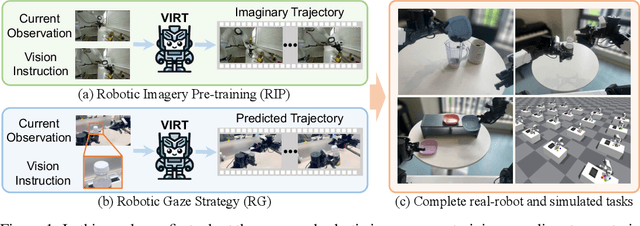

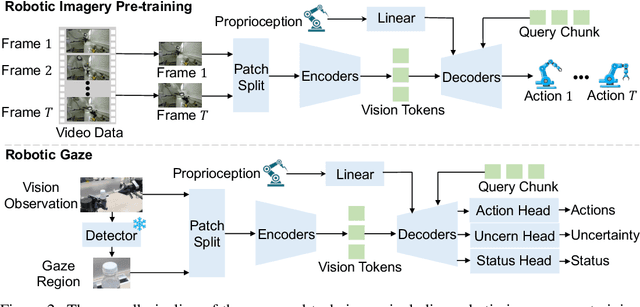
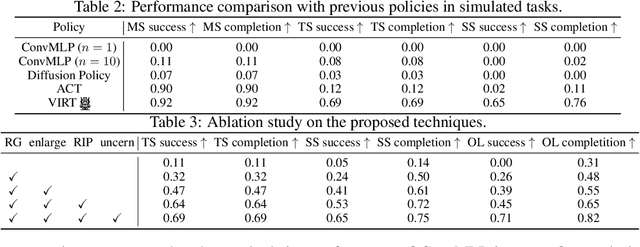
Abstract:Robotic manipulation, owing to its multi-modal nature, often faces significant training ambiguity, necessitating explicit instructions to clearly delineate the manipulation details in tasks. In this work, we highlight that vision instruction is naturally more comprehensible to recent robotic policies than the commonly adopted text instruction, as these policies are born with some vision understanding ability like human infants. Building on this premise and drawing inspiration from cognitive science, we introduce the robotic imagery paradigm, which realizes large-scale robotic data pre-training without text annotations. Additionally, we propose the robotic gaze strategy that emulates the human eye gaze mechanism, thereby guiding subsequent actions and focusing the attention of the policy on the manipulated object. Leveraging these innovations, we develop VIRT, a fully Transformer-based policy. We design comprehensive tasks using both a physical robot and simulated environments to assess the efficacy of VIRT. The results indicate that VIRT can complete very competitive tasks like ``opening the lid of a tightly sealed bottle'', and the proposed techniques boost the success rates of the baseline policy on diverse challenging tasks from nearly 0% to more than 65%.
FP-VEC: Fingerprinting Large Language Models via Efficient Vector Addition
Sep 13, 2024Abstract:Training Large Language Models (LLMs) requires immense computational power and vast amounts of data. As a result, protecting the intellectual property of these models through fingerprinting is essential for ownership authentication. While adding fingerprints to LLMs through fine-tuning has been attempted, it remains costly and unscalable. In this paper, we introduce FP-VEC, a pilot study on using fingerprint vectors as an efficient fingerprinting method for LLMs. Our approach generates a fingerprint vector that represents a confidential signature embedded in the model, allowing the same fingerprint to be seamlessly incorporated into an unlimited number of LLMs via vector addition. Results on several LLMs show that FP-VEC is lightweight by running on CPU-only devices for fingerprinting, scalable with a single training and unlimited fingerprinting process, and preserves the model's normal behavior. The project page is available at https://fingerprintvector.github.io .
LARM: Large Auto-Regressive Model for Long-Horizon Embodied Intelligence
May 27, 2024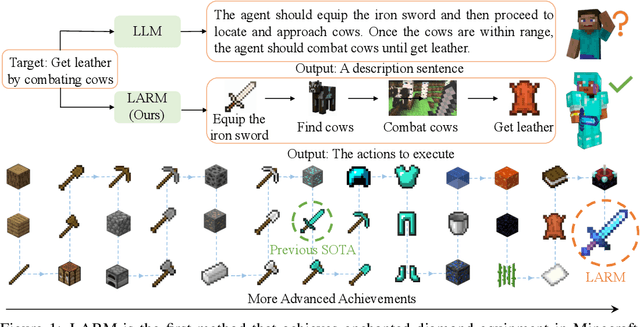
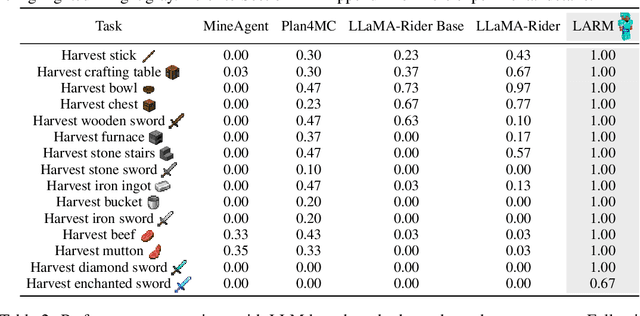
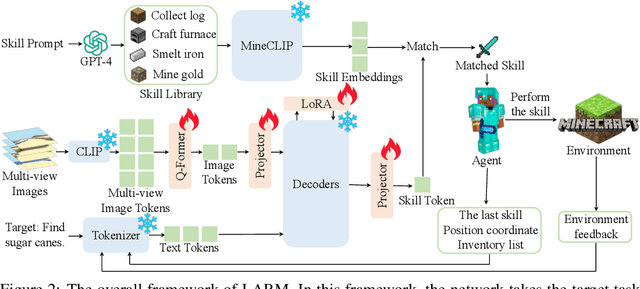

Abstract:Due to the need to interact with the real world, embodied agents are required to possess comprehensive prior knowledge, long-horizon planning capability, and a swift response speed. Despite recent large language model (LLM) based agents achieving promising performance, they still exhibit several limitations. For instance, the output of LLMs is a descriptive sentence, which is ambiguous when determining specific actions. To address these limitations, we introduce the large auto-regressive model (LARM). LARM leverages both text and multi-view images as input and predicts subsequent actions in an auto-regressive manner. To train LARM, we develop a novel data format named auto-regressive node transmission structure and assemble a corresponding dataset. Adopting a two-phase training regimen, LARM successfully harvests enchanted equipment in Minecraft, which demands significantly more complex decision-making chains than the highest achievements of prior best methods. Besides, the speed of LARM is 6.8x faster.
DriveGPT4: Interpretable End-to-end Autonomous Driving via Large Language Model
Oct 08, 2023Abstract:In the past decade, autonomous driving has experienced rapid development in both academia and industry. However, its limited interpretability remains a significant unsolved problem, severely hindering autonomous vehicle commercialization and further development. Previous approaches utilizing small language models have failed to address this issue due to their lack of flexibility, generalization ability, and robustness. Recently, multimodal large language models (LLMs) have gained considerable attention from the research community for their capability to process and reason non-text data (e.g., images and videos) by text. In this paper, we present DriveGPT4, an interpretable end-to-end autonomous driving system utilizing LLMs. DriveGPT4 is capable of interpreting vehicle actions and providing corresponding reasoning, as well as answering diverse questions posed by human users for enhanced interaction. Additionally, DriveGPT4 predicts vehicle low-level control signals in an end-to-end fashion. These capabilities stem from a customized visual instruction tuning dataset specifically designed for autonomous driving. To the best of our knowledge, DriveGPT4 is the first work focusing on interpretable end-to-end autonomous driving. When evaluated on multiple tasks alongside conventional methods and video understanding LLMs, DriveGPT4 demonstrates superior qualitative and quantitative performance. Additionally, DriveGPT4 can be generalized in a zero-shot fashion to accommodate more unseen scenarios. The project page is available at https://tonyxuqaq.github.io/projects/DriveGPT4/ .
InsightMapper: A Closer Look at Inner-instance Information for Vectorized High-Definition Mapping
Aug 16, 2023Abstract:Vectorized high-definition (HD) maps contain detailed information about surrounding road elements, which are crucial for various downstream tasks in modern autonomous driving vehicles, such as vehicle planning and control. Recent works have attempted to directly detect the vectorized HD map as a point set prediction task, resulting in significant improvements in detection performance. However, these approaches fail to analyze and exploit the inner-instance correlations between predicted points, impeding further advancements. To address these challenges, we investigate the utilization of inner-$\textbf{INS}$tance information for vectorized h$\textbf{IGH}$-definition mapping through $\textbf{T}$ransformers and introduce InsightMapper. This paper presents three novel designs within InsightMapper that leverage inner-instance information in distinct ways, including hybrid query generation, inner-instance query fusion, and inner-instance feature aggregation. Comparative experiments are conducted on the NuScenes dataset, showcasing the superiority of our proposed method. InsightMapper surpasses previous state-of-the-art (SOTA) methods by 5.78 mAP and 5.12 TOPO, which assess topology correctness. Simultaneously, InsightMapper maintains high efficiency during both training and inference phases, resulting in remarkable comprehensive performance. The project page for this work is available at https://tonyxuqaq.github.io/projects/InsightMapper .
FSNet: Redesign Self-Supervised MonoDepth for Full-Scale Depth Prediction for Autonomous Driving
Apr 21, 2023Abstract:Predicting accurate depth with monocular images is important for low-cost robotic applications and autonomous driving. This study proposes a comprehensive self-supervised framework for accurate scale-aware depth prediction on autonomous driving scenes utilizing inter-frame poses obtained from inertial measurements. In particular, we introduce a Full-Scale depth prediction network named FSNet. FSNet contains four important improvements over existing self-supervised models: (1) a multichannel output representation for stable training of depth prediction in driving scenarios, (2) an optical-flow-based mask designed for dynamic object removal, (3) a self-distillation training strategy to augment the training process, and (4) an optimization-based post-processing algorithm in test time, fusing the results from visual odometry. With this framework, robots and vehicles with only one well-calibrated camera can collect sequences of training image frames and camera poses, and infer accurate 3D depths of the environment without extra labeling work or 3D data. Extensive experiments on the KITTI dataset, KITTI-360 dataset and the nuScenes dataset demonstrate the potential of FSNet. More visualizations are presented in \url{https://sites.google.com/view/fsnet/home}
RNGDet++: Road Network Graph Detection by Transformer with Instance Segmentation and Multi-scale Features Enhancement
Sep 21, 2022
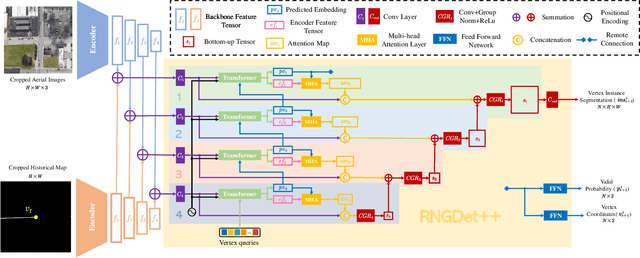
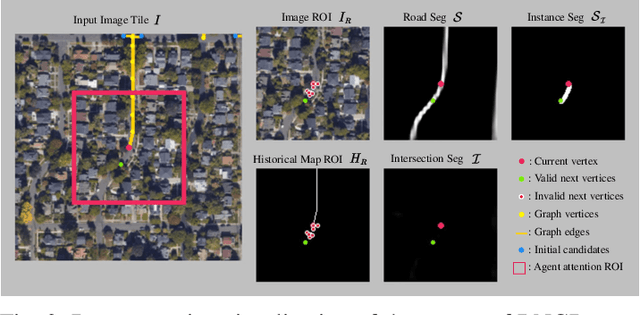
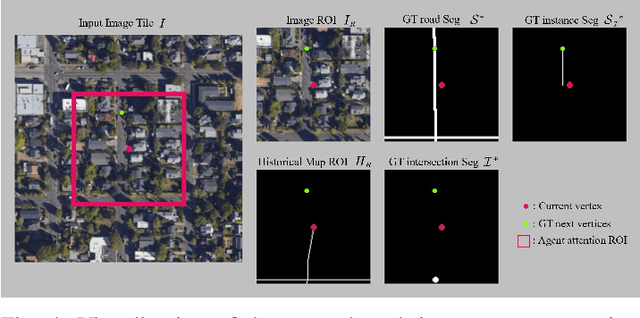
Abstract:The graph structure of road networks is critical for downstream tasks of autonomous driving systems, such as global planning, motion prediction and control. In the past, the road network graph is usually manually annotated by human experts, which is time-consuming and labor-intensive. To obtain the road network graph with better effectiveness and efficiency, automatic approaches for road network graph detection are required. Previous works either post-process semantic segmentation maps or propose graph-based algorithms to directly predict the road network graph. However, previous works suffer from hard-coded heuristic processing algorithms and inferior final performance. To enhance the previous SOTA (State-of-the-Art) approach RNGDet, we add an instance segmentation head to better supervise the model training, and enable the model to leverage multi-scale features of the backbone network. Since the new proposed approach is improved from RNGDet, it is named RNGDet++. All approaches are evaluated on a large publicly available dataset. RNGDet++ outperforms baseline models on almost all metrics scores. It improves the topology correctness APLS (Average Path Length Similarity) by around 3\%. The demo video and supplementary materials are available on our project page \url{https://tonyxuqaq.github.io/projects/RNGDetPlusPlus/}.
 Add to Chrome
Add to Chrome Add to Firefox
Add to Firefox Add to Edge
Add to Edge